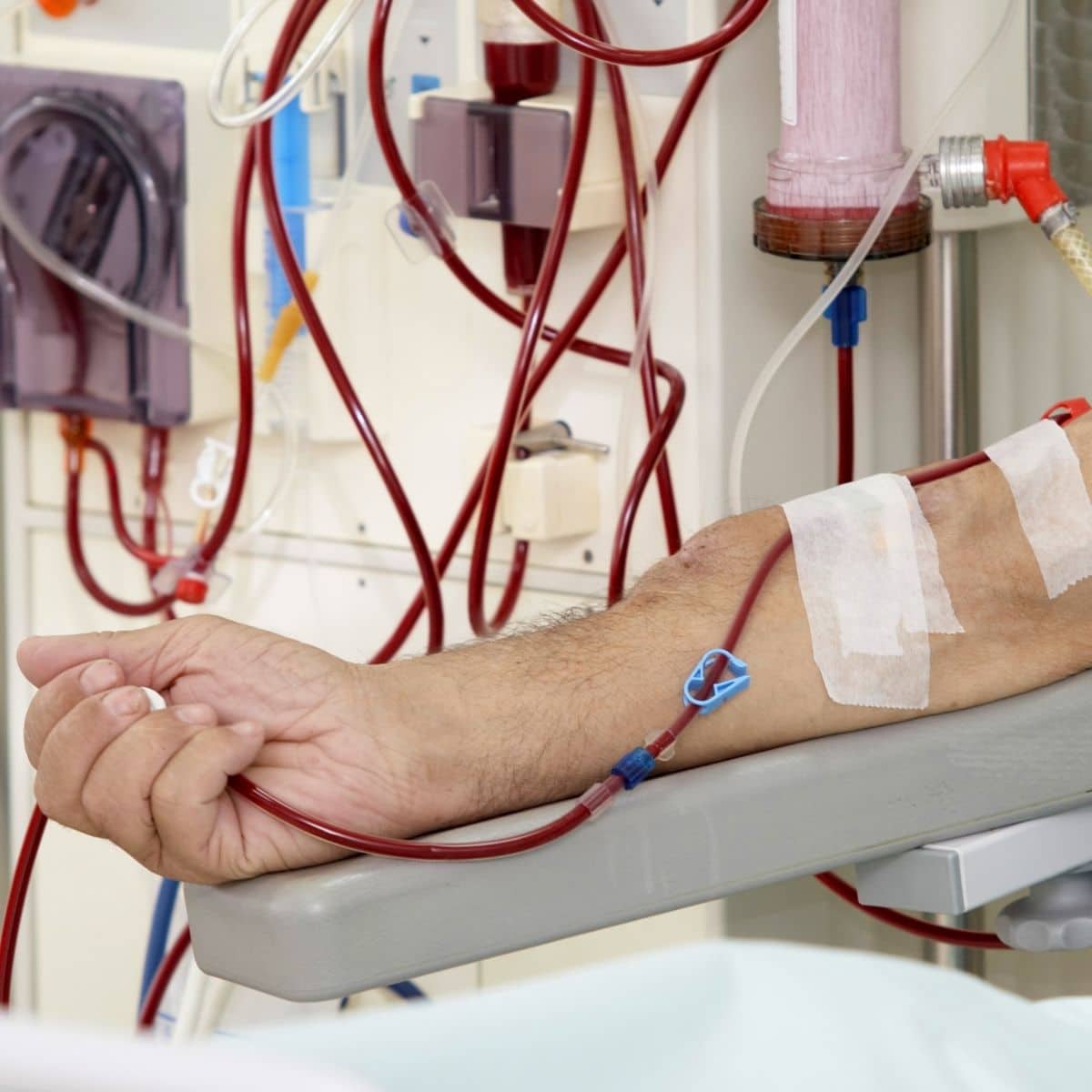What To Expect With Dialysis
Every year, hundreds of thousands of people go through dialysis for end stage renal disease. For many people, dialysis is an impending event on the horizon. Yes, there are even end stage renal failure diet recipes.
If dialysis might be in your future, you may be feeling scared or unsure about what to expect. Sometimes, the unknown is a lot scarier than the reality. Understanding what dialysis is and what to expect as a dialysis patient may help to put your nerves to rest.

As you enter the world of dialysis, it's important to remember that this treatment is a necessary process for individuals with end-stage renal disease or kidney failure.
Dialysis involves filtering waste and excess fluid from your blood since your kidneys can no longer do so on their own. It's important to also know the fluid restriction guidelines for CKD.
There are two types of dialysis: hemodialysis, which requires going to a treatment center, and peritoneal dialysis, which can be done at home. With either option, discomfort is minimal and should not limit your normal active lifestyle.
Jump to:
Overview
Dialysis is a process that filters waste and excess fluid from your blood when your kidneys are not functioning properly. This procedure is essential if you have end-stage renal disease or sudden kidney failure.
During hemodialysis at a treatment center, you'll visit three times per week for 3-4 hours per session. A dialysis catheter may be used for short-term treatment, while more permanent access will be needed for longer-term dialysis. Your healthcare provider will take charge of you during the entire process to ensure it runs smoothly and safely.
Dialysis can cause some side effects like nausea, muscle cramps, dizziness, or headaches after the first couple of sessions. You might also feel tired after each session as well as experience symptoms caused by too much fluid in your body if you don't follow the recommended diet strictly.
However, with proper management and compliance with all instructions given by your healthcare team, you can still maintain an active lifestyle without limitations. You can also check out how to manage chronic kidney disease.
For More Recipes and Ideas --->> Get Your Free Meals and Recipes That Are Perfect for Pre-Dialysis Diets, Pre-Dialysis with Diabetes, or Dialysis Diets.
Types of Dialysis
The two types of dialysis, hemodialysis and peritoneal dialysis, have different requirements when it comes to time and location.
Hemodialysis requires going to a treatment center for sessions that can last up to 3-4 hours, three times a week. On the other hand, peritoneal dialysis is done at home and needs to be performed daily.
Hemodialysis relies on an access point to blood vessels, which can be established through a catheter for short-term use or more permanent access for longer-term treatment.
On the other hand, patients typically receive education on how to perform peritoneal dialysis at home from nurses.
During hemodialysis sessions at a treatment center, patients can read, watch TV or chat with their providers and other patients while receiving the necessary treatment.
Is home hemodialysis right for you? Here's a an outline of the main differences between hemodialysis and peritoneal dialysis:

Hemodialysis:
- Process: Blood is filtered outside the body through a machine called a dialyzer.
- Access: Requires the creation of an arteriovenous fistula, graft, or the use of a catheter to access the bloodstream.
- Frequency: Typically done three times a week for several hours per session at a dialysis center.
- Procedure duration: Each session lasts around 3-4 hours.
- Need for caregiver assistance: Usually requires assistance from healthcare professionals or caregivers.
- Fluid removal: Efficiently removes excess fluid and waste products from the blood.
- Lifestyle restrictions: Restricts dietary choices and fluid intake.
- Mobility: Limits mobility during dialysis sessions.
Peritoneal dialysis:
- Process: A dialysis solution is infused into the abdomen through a catheter, and waste products are removed through the peritoneal membrane.
- Access: Requires the placement of a catheter into the abdominal cavity.
- Frequency: Can be done daily or several times a day at home.
- Procedure duration: Each session typically lasts 4-6 hours, but the process is continuous.
- Need for caregiver assistance: Can be performed independently at home with proper training.
- Fluid removal: May not be as efficient as hemodialysis in removing excess fluid.
- Lifestyle restrictions: Offers more flexibility in dietary choices and fluid intake.
- Mobility: Permits more mobility during the dialysis process.
It's important to note that the choice between hemodialysis and peritoneal dialysis depends on various factors, including the patient's overall health, lifestyle, and personal preferences. It's more than okay to seek heart healthy lifestyle changes for CKD.
It's also vital for patients to understand these differences in order to determine which type of dialysis is best suited for them and their lifestyle.
Access and Needles
When you undergo hemodialysis, the healthcare provider will need to establish a vascular access point using needles, which may cause some discomfort but is necessary for the treatment.
The most common type of access is a arteriovenous fistula (AV fistula), which is created by connecting an artery and vein in your arm. This creates a larger blood vessel that can be used for dialysis. Another type of access is an AV graft, which involves using a synthetic tube to connect an artery and vein.
The needles used for hemodialysis are larger than typical medical needles and are inserted into the access point during each treatment session. While this may sound daunting, many patients report that the discomfort is minimal or manageable with numbing cream or local anesthesia.
It's important to remember that these needles are necessary for effective dialysis treatment.
To ensure proper healing and function of your access point, it's important to follow all instructions from your healthcare team regarding care and maintenance.
You should also avoid any activities that could damage your access point, such as wearing tight clothing or carrying heavy objects on the arm where your access point is located.
Remember: taking good care of your access means taking good care of yourself overall during hemodialysis treatment.

Treatment Sessions
Upon arrival at the dialysis center, you will be weighed to assess your interdialytic weight gain or your weight between treatments. This can help assess how much fluid was retained in your body between dialysis sessions.
Knowing how much weight you gained can help decisions regarding your care, such as how much fluid will be extracted during the treatment session (net ultrafiltrate).
A doctor on duty at the dialysis unit will evaluate you and ask regarding symptoms such as swelling, fever, and shortness of breath. You will also be examined for signs of fluid retention such as edema in your extremities or crackles in the lungs.
During hemodialysis treatment sessions, healthcare providers use large needles to access the patient's fistula or graft. Once the needles are in place, the blood flows through tubes to a dialysis machine where it's filtered and then returned to the body through another needle.
While undergoing hemodialysis, patients usually have 3-4 hour sessions, three times a week at a treatment center. During this time, patients can relax and engage in activities like reading or watching TV. Additionally, members of your dialysis care team are always on hand to monitor the process and address any issues that arise. It's also wise to learn how to avoid caregiver burnout.
Patients may also experience side effects like nausea or headaches during their first few sessions, but these typically dissipate over time.
It's important for patients to understand that dialysis is not a quick fix solution and requires regular commitment to this care plan. If you miss a session, waste products will build up in your bloodstream causing symptoms like fatigue and swelling.
That said, if you follow your prescribed treatment plan carefully and attend all scheduled appointments with your healthcare provider, you'll be able to manage your kidney disease effectively while still enjoying an active lifestyle.
At-Home Dialysis
If you're looking for a way to manage your kidney disease from the comfort of your own home, at-home dialysis may be an option worth considering.
With this type of treatment, you can perform peritoneal dialysis daily in the privacy of your own home. A healthcare provider will teach you how to do it and will monitor your progress.
During at-home dialysis, you'll need to follow a strict schedule and diet plan. You'll also need to keep track of your fluid intake and weight. Your healthcare provider will give you specific instructions on how much fluid to remove during each session and how often to check your weight.
One benefit of at-home dialysis is that it allows for more flexibility in scheduling treatments. You won't have to travel back and forth between a treatment center, which can save time and money. However, it's important to attend all scheduled appointments with your healthcare provider and notify them if any problems arise during treatment.
Overall, at-home dialysis can provide a convenient option for managing kidney disease while maintaining independence and privacy.
Potential Side Effects
While discomfort is generally minor for most patients, some may experience nausea, cramping, dizziness, and headaches during their first few sessions. These symptoms usually subside as the patient becomes more accustomed to the treatment. However, if they persist or worsen over time, it's essential to contact your healthcare provider.
As a new patient undergoing dialysis, you may experience hypotension or drop in blood pressure as a common side effect. Hypotension, or low blood pressure, can occur during or after dialysis due to the rapid removal of fluid and changes in blood volume. This can lead to symptoms such as dizziness, lightheadedness, nausea, and even fainting.
To manage hypotension, your healthcare team will closely monitor your blood pressure during dialysis sessions and may make adjustments to your treatment, such as slowing down fluid removal or adjusting medication dosages (diet vs medication for CKD improvement).
It's important to communicate any symptoms you experience to your healthcare provider, as they can provide guidance and help ensure your comfort and safety during dialysis.
Also, while rare, blood infections can occur at the site where the catheter enters your body for dialysis treatments. Symptoms of infection include chills, swelling, warmth around the catheter site, fever over 100.5°F and increased pain around the area.
It's crucial to notify your healthcare provider immediately if you experience any signs of infection as prompt treatment can prevent serious complications.
Overall, understanding these potential side effects can help you be prepared for what to expect with dialysis treatments so that you can take proactive measures and communicate effectively with your healthcare team if necessary.
Signs of Complications
Can kidney disease cause heart problems? Watch out for warning signs, as they can signal potential complications in your kidney disease treatment. Don't let them catch you off guard - stay vigilant and proactive in caring for your health.
Some common signs of complications during dialysis include bleeding, abdominal pain, infection, fever over 100.5°F, swelling in the arm where dialysis access is placed, and coldness, numbness or weakness in the hand. If you experience any of these symptoms during or after a dialysis session, it's important to contact your medical care provider immediately.
Additionally, if you experience severe symptoms such as chest pain or difficulty breathing during treatment, inform your provider right away. It's always better to err on the side of caution when it comes to your health.
Remember that regular communication with your healthcare team is key to avoiding complications during dialysis.
Make sure to follow their instructions closely and attend all scheduled appointments. By staying informed and taking an active role in managing your kidney disease treatment, you can minimize the risks associated with dialysis and lead a healthy life despite this condition
Dialysis Diet
To keep your body healthy while undergoing treatment, it's important to follow a specific diet designed for individuals with kidney disease on dialysis. This diet is crucial as it helps control the levels of minerals, electrolytes, and fluids in your body, which can cause complications if not controlled.
Your healthcare provider will give you a personalized meal plan based on your condition, age, weight, and other health factors. The dialysis diet mostly involves limiting foods that are high in sodium, potassium, and phosphorus, while adding healthy sources of protein. There is also a low cholesterol meal plan worth checking out.
You'll be advised to avoid salted snacks like chips or pretzels and processed meats like ham or bacon which contain high amounts of sodium. Foods rich in potassium such as bananas, oranges, and tomatoes should also be limited. Moreover, dairy products like milk or cheese that are high in phosphorus may need to be restricted.
It's essential to keep track of what you eat during dialysis as even small deviations from your prescribed diet can affect the effectiveness of the treatment.
You will also need regular blood tests to monitor for anemia as well as electrolytes, blood sugar, blood creatinine, urea nitrogen, and others. Always consult with your healthcare provider before making any changes to your meal plan as they can help you adjust it accordingly.
With proper adherence to the dialysis diet along with regular sessions, you can ensure optimal health outcomes while undergoing this necessary treatment for kidney disease.
Length of Treatment
During your dialysis sessions at a treatment center, you'll typically spend 3-4 hours with healthcare providers and other patients while your blood is filtered to remove waste and excess fluid (fluid restricted diet menu).
This length of time may vary depending on several factors such as the severity of your kidney disease, how much fluid needs to be removed from your body, and any complications that may arise during treatment. While this may seem like a long time, it's important to attend all scheduled sessions to keep your body healthy.
If you choose home dialysis instead of going to a treatment center, your sessions will typically be longer - around 4-6 hours each day. During these sessions, you'll be responsible for performing the dialysis yourself with guidance from a trained nurse. It's essential that you follow their instructions carefully to ensure effective treatment.
While it can be difficult to dedicate so much time to dialysis each week, remember that this treatment is necessary for people with kidney disease. This is because in renal failure, the kidneys will not be able to filter out harmful wastes anymore.
By attending all scheduled sessions and following the advice of your healthcare provider, you can help manage symptoms and live an active lifestyle despite having end stage renal disease.
Travel and Work
If you love to travel or work, don't let kidney disease hold you back - with proper planning and communication with your healthcare provider, you can still enjoy these activities while receiving necessary dialysis treatment.
Before embarking on any trips or starting a new job, make sure to talk to your healthcare provider about your dialysis schedule and how it can be accommodated. They may be able to help you find a treatment center in the area where you'll be traveling or working.
If you plan on traveling internationally, it's important to research dialysis centers ahead of time. Not all countries have the same quality of care for kidney disease as others, so it's crucial to plan accordingly. Additionally, make sure that any medications or supplies needed for your treatment are legal or available in the country you'll be visiting.
When it comes to work, most employers are required by law to provide reasonable accommodations for employees with disabilities. This includes allowing time off for medical treatments such as dialysis. Make sure to communicate openly with your employer about your needs and schedule so that they can provide appropriate support.
With proper planning and communication, there's no reason why kidney disease should limit your ability to travel and work.
FAQs About What To Expect With Dialysis
Dialysis isn't a cure for kidney disease, but it's necessary for those with end stage renal disease or sudden kidney failure.
It replaces the normal function of kidneys in removing waste and excess fluid from the blood through a complex process that requires trained healthcare providers.
Hemodialysis at a treatment center typically lasts 3-4 hours, 3 times a week, while home dialysis sessions are shorter. Dialysis patients must follow a specific diet and attend all scheduled sessions to avoid symptoms caused by too much fluid in the body.
While dialysis may be uncomfortable for some patients, the majority report minor discomfort and that it doesn't limit their normal, active lifestyle.
If you're considering treatment for kidney disease, it's important to understand the success rates of different options. While dialysis can be effective in removing waste and excess fluid from the blood, it isn't a permanent solution.
On the other hand, kidney transplant offers a much higher success rate in terms of long-term outcomes and overall quality of life. Studies have shown that patients who receive a kidney transplant typically live longer and experience fewer complications than those who rely on dialysis alone.
Questions about kidney transplant? However, it's important to note that transplantation requires finding a suitable donor and undergoing surgery, which may involve some risks and challenges. Ultimately, the decision between dialysis and transplant will depend on your individual needs and circumstances.
If you're wondering about the cost of dialysis, it's important to know that this treatment can be quite expensive.
The exact cost may vary depending on factors such as your location and insurance coverage. However, one study found that the average cost for dialysis is around $40,000 per year.
It's important to talk with your healthcare provider and insurance company to understand what costs you may be responsible for and what financial assistance options may be available to you.
Imagine if you could have more free time and less stress in your life while still receiving the necessary treatment for your kidney disease. Well, the answer may be yes!
Dialysis can actually be done less frequently than the traditional 2-3 times a week. However, it's important to consult with your healthcare provider to determine if this option is right for you. Factors such as age, overall health, and severity of kidney disease will all play a role in deciding the best treatment plan.
So don't hesitate to ask about alternative options that may give you more flexibility in your schedule while still ensuring optimal health outcomes.
If you have kidney disease, there are alternative treatments to dialysis. A kidney transplant is one option, but it may not be suitable for everyone.
Another option is conservative management, which involves managing symptoms and slowing the progression of the disease through medication and lifestyle changes.
However, this approach does not replace the need for dialysis or a transplant in advanced stages of chronic kidney disease, especially if you already have the end stage renal failure.
It's important to discuss all treatment options with your healthcare provider to determine what's best for you.
Dialysis Gives You A New Lease On Life
Reaching the point of needing dialysis is not the end of your life as you know it. It may be time consuming and even uncomfortable at points, but for the most part dialysis is much easier to deal with than most people think.
Dialysis is a life-saving treatment and you can even still live your normal, active lives as long as your doctor has not told you otherwise. With proper access and needles for treatment sessions, following a dialysis diet to maintain good health, taking travel and work into consideration, and knowing the signs of complications - you can successfully manage your condition.
Dialysis requires some adjustments in your daily life, but with determination and support from healthcare professionals and loved ones - you can lead a fulfilling life even while on dialysis.















